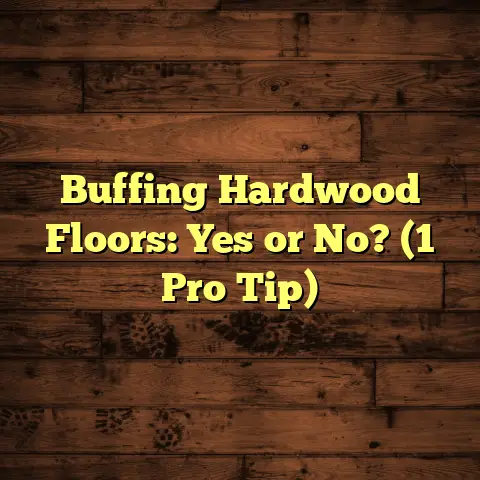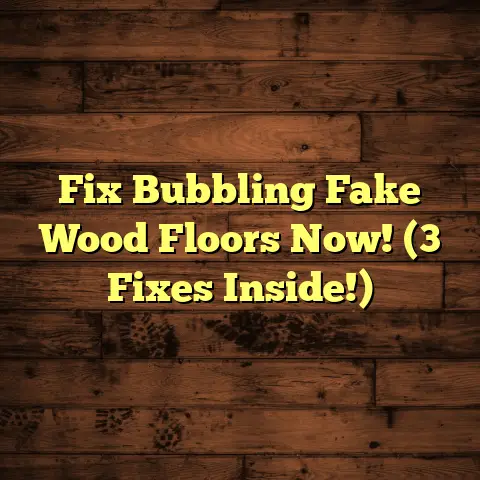Refinishing Hardwood Floors: How Many Times? (2 Max!)
Ever walked into a room and been completely wowed by the hardwood floors?
That warm, inviting glow, the beautiful grain patterns… it’s magic!
But let’s face it, life happens. Scratches, dents, and a general dullness can creep in.
That’s when the thought pops into your head: “Can I refinish these floors and bring back that original sparkle?”
And more importantly, “How many times can I actually do it?”
That’s the question we’re tackling today.
As a flooring contractor with years of experience under my belt, I’ve seen it all.
I’ve witnessed stunning transformations and, unfortunately, a few flooring refinishing disasters.
So, let’s dive into the world of hardwood floor refinishing and uncover the truth about that “two-time” limit.
1. Understanding Hardwood Floors
First, let’s get a solid foundation.
What exactly is hardwood flooring?
Basically, it’s flooring made from a single piece of wood, harvested from trees like oak, maple, or cherry. These trees are known for their density and durability.
Think of it as the “real deal” compared to engineered wood or laminate.
Popular Types of Hardwood
You’ve got tons of options here, each with its own unique look and feel:
-
Oak: The classic choice! It’s durable, readily available, and takes stain beautifully. (Red Oak and White Oak are the most popular variations.)
-
Maple: Known for its light color and smooth grain, maple offers a more modern vibe.
-
Hickory: One of the hardest domestic woods, hickory is super durable and has a distinctive grain pattern.
-
Cherry: Rich, reddish-brown tones make cherry a more luxurious option.
-
Walnut: Dark and elegant, walnut adds a touch of sophistication to any space.
Lifespan and Durability
A well-maintained hardwood floor can easily last for decades – even a century!
That said, the lifespan depends on factors like the type of wood, the finish, and how much foot traffic it endures.
Think of it this way: a floor in a quiet bedroom will last much longer than one in a busy hallway.
2. The Refinishing Process
Okay, let’s talk about the nitty-gritty.
What actually happens when you refinish a hardwood floor?
Essentially, it’s a process of sanding away the old finish and any surface damage, then applying a fresh coat of stain and sealant.
Step-by-Step Breakdown
-
Assessment: First, I’ll take a close look at your floors to assess the damage. Are there just scratches, or are there deeper issues like water damage or warping? This helps determine if refinishing is even the right solution.
-
Preparation: Next, we’ll need to clear the room completely. Then, we’ll thoroughly clean the floors to remove any dirt, dust, or debris.
-
Sanding: This is where the magic happens! Using a drum sander (for large areas) and an edge sander (for corners and edges), we’ll carefully sand away the old finish and smooth out any imperfections. This usually involves multiple passes with different grits of sandpaper, starting coarse and working our way to fine.
-
Staining (Optional): If you want to change the color of your floors, now’s the time! We’ll apply a stain evenly, let it sit for the recommended time, and then wipe off the excess.
-
Sealing: This is the final step, and it’s crucial for protecting your floors. We’ll apply several coats of polyurethane or another sealant, allowing each coat to dry completely before applying the next. This creates a durable, protective layer that will resist scratches, stains, and wear.
Tools and Materials
You’ll need a good arsenal of tools:
-
Drum sander & Edge sander: These are the big guns for sanding. You can rent these from most home improvement stores.
-
Sandpaper: A variety of grits, from coarse to fine, is essential for achieving a smooth finish.
-
Stain (optional): Choose a color that complements your décor.
-
Polyurethane or Sealer: This protects your floors from damage.
-
Applicators: Brushes, rollers, and staining pads are needed for applying stain and sealant.
-
Safety Gear: Dust mask, safety glasses, and ear protection are a must! Sanding creates a lot of dust.
Professional vs. DIY
Can you tackle this yourself? Absolutely! Many homeowners do.
However, it’s not a walk in the park.
Sanding is tricky – one wrong move and you can gouge your floors.
Plus, the dust is a major hassle.
Hiring a professional ensures a smooth, even finish and saves you time and stress.
According to HomeAdvisor, professional hardwood floor refinishing costs between \$3 and \$8 per square foot, including materials and labor.
DIY can save you money on labor, but you’ll need to factor in the cost of renting equipment and buying materials, plus the potential for mistakes.
3. Signs That Refinishing Is Needed
How do you know when it’s time to refinish your hardwood floors?
Keep an eye out for these telltale signs:
-
Scratches: Minor scratches are normal, but deep, noticeable scratches detract from the floor’s appearance.
-
Dullness: Over time, the finish wears down, leaving your floors looking dull and lifeless.
-
Water Damage: Stains or discoloration from water spills can be a sign that the finish has been compromised.
-
Worn-Through Finish: If you can see bare wood in high-traffic areas, it’s definitely time to refinish.
Refinish or Replace?
Sometimes, the damage is too extensive for refinishing. If you have:
-
Significant Warping: Buckling or warping indicates structural damage.
-
Extensive Water Damage: Rot or mold growth may necessitate replacement.
-
Irreparable Gouges: Deep gouges that can’t be sanded out may require replacing individual boards or the entire floor.
Environmental Factors
Humidity and sunlight can wreak havoc on hardwood floors.
-
Humidity: Excessive humidity can cause wood to expand and contract, leading to warping and cracking.
-
Sunlight: Prolonged exposure to direct sunlight can fade the color of your floors.
Using rugs and curtains can help protect your floors from these environmental factors.
4. The Two-Time Limitation:
Why Only Twice?
Okay, here’s the heart of the matter.
Why do I, and most flooring pros, recommend a maximum of two refinishings?
It all comes down to the construction of your hardwood floors and the “wear layer.”
Solid vs. Engineered Hardwood
-
Solid Hardwood: This is what most people think of when they hear “hardwood.” It’s a solid piece of wood from top to bottom.
-
Engineered Hardwood: This consists of a thin layer of hardwood veneer bonded to a core of plywood or fiberboard.
The key difference? Solid hardwood has a much thicker wear layer than engineered hardwood.
Understanding the Wear Layer
The wear layer is the amount of wood above the tongue and groove.
It’s the part that can be sanded down during refinishing.
Solid hardwood typically has a wear layer of about 1/4 inch (6mm) to 5/16 inch (8mm).
Engineered hardwood, on the other hand, may have a wear layer as thin as 1/32 inch (0.8mm).
The Impact of Sanding
Each time you refinish your floors, you’re sanding away a portion of the wear layer.
If you sand too aggressively or too many times, you can sand right through the wear layer, exposing the tongue and groove.
Once that happens, your floors are ruined and will need to be replaced.
With solid hardwood, you generally have enough wear layer for two refinishings.
Engineered hardwood, with its thin veneer, may only be able to handle one very light refinishing – or none at all.
Industry Standards
While there’s no official “rule,” most flooring professionals agree that two refinishings is a safe maximum for solid hardwood.
This allows for some wiggle room in case the first sanding is a bit aggressive.
However, it’s crucial to have a professional assess your floors before each refinishing to determine if there’s enough wear layer remaining.
5. Alternatives to Refinishing
What if your floors need some love, but you’re not ready for a full refinishing?
Luckily, there are other options!
Maintaining Your Floors
Prevention is key! Regular cleaning and maintenance can extend the life of your hardwood floors and reduce the need for frequent refinishing.
-
Sweep or vacuum regularly: This removes dirt and debris that can scratch the finish.
-
Use mats and rugs: Place mats at entrances and rugs in high-traffic areas to protect your floors from wear and tear.
-
Avoid harsh chemicals: Use a pH-neutral cleaner specifically designed for hardwood floors.
-
Clean up spills immediately: Water and other liquids can damage the finish.
Screening and Recoating
This is a less invasive alternative to full refinishing.
It involves lightly abrading the existing finish (screening) and then applying a fresh coat of polyurethane (recoating).
This can refresh the appearance of your floors and add a layer of protection without removing a significant amount of the wear layer.
When to Replace
As mentioned earlier, sometimes replacement is the only option.
If your floors have extensive damage, warping, or rot, it’s time to start shopping for new flooring.
According to Statista, the hardwood flooring market in the U.S. is projected to reach \$6.4 billion in 2024.
So, you’ve got plenty of options to choose from!
6. Cost Considerations
Let’s talk money. Refinishing hardwood floors is an investment, so it’s important to understand the costs involved.
Average Refinishing Costs
As I mentioned earlier, professional refinishing typically costs between \$3 and \$8 per square foot.
This includes the cost of labor, materials, and equipment rental.
The exact cost will depend on factors like the size of the area, the type of wood, and the complexity of the job.
DIY vs. Professional
DIY refinishing can save you money on labor costs, but you’ll need to factor in the cost of renting equipment, buying materials, and the potential for mistakes.
Plus, it’s a lot of hard work!
For example, renting a drum sander can cost around \$50-\$100 per day, and you’ll need to buy sandpaper, stain, and sealant as well.
Long-Term Value
Refinishing your hardwood floors can significantly increase the value of your home.
According to a 2023 report by the National Association of Realtors, refinishing hardwood floors has an estimated return on investment (ROI) of 100%.
That means you can expect to recoup the entire cost of the project when you sell your home.
7. Case Studies and Real-Life Experiences
Let’s hear from some real people who’ve been through the hardwood floor refinishing process.
I recently spoke with Sarah, a homeowner who refinished her oak floors herself.
“It was definitely a learning experience!” she told me. “The sanding was the hardest part. I accidentally gouged the floor in a few spots, but luckily, I was able to fix it.”
On the other hand, Mark hired a professional to refinish his maple floors.
“It was worth every penny,” he said. “The floors look amazing, and I didn’t have to lift a finger!”
Lessons Learned
Here are a few key takeaways from these real-life experiences:
-
Preparation is key: Thoroughly cleaning and preparing the floors before sanding is essential for a smooth finish.
-
Sanding is tricky: Take your time and be careful not to gouge the floors.
-
Ventilation is important: Sanding creates a lot of dust, so make sure to ventilate the area well.
-
Don’t rush the process: Allow each coat of stain and sealant to dry completely before applying the next.
8. Conclusion: The Path Forward for Your Hardwood Floors
So, there you have it!
The truth about refinishing hardwood floors: two times is generally the maximum.
Remember, it all comes down to the wear layer and the amount of wood that can be safely sanded away.
By understanding the refinishing process, maintaining your floors properly, and knowing when to call in a professional, you can keep your hardwood floors looking beautiful for years to come.
Don’t be afraid to show your floors some love!
With a little care and attention, they’ll continue to add warmth, character, and value to your home for generations.
Thanks for joining me on this flooring adventure! Happy refinishing!





